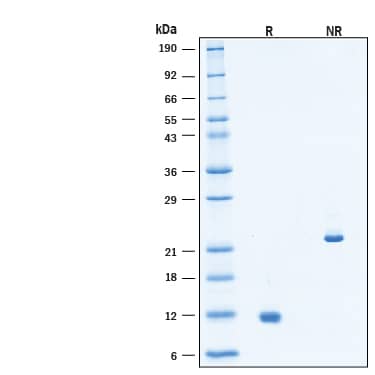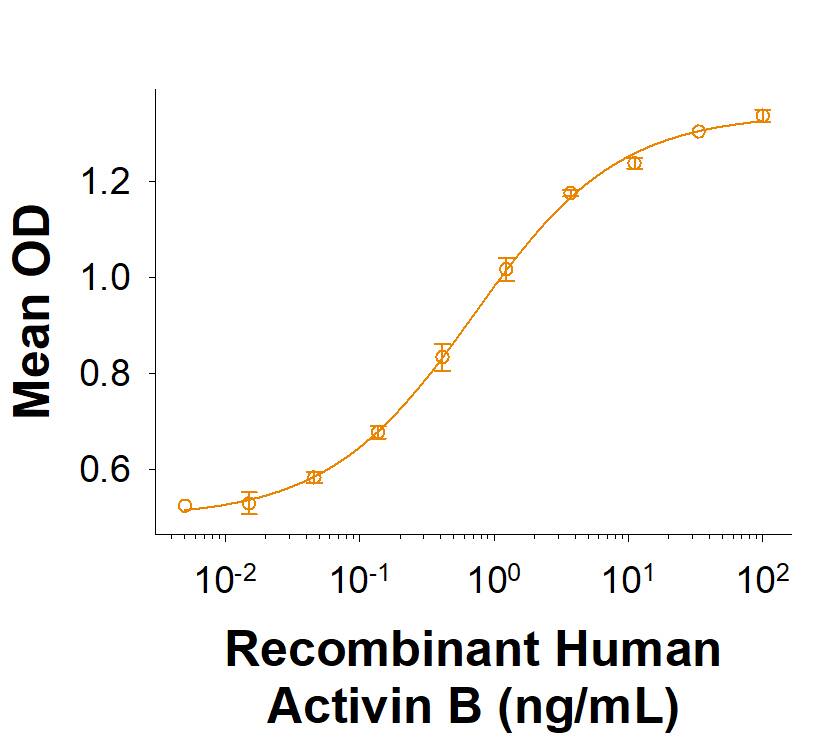Recombinant Human Activin B Protein, CF
R&D Systems, part of Bio-Techne | Catalog # 11517-AB

Key Product Details
Source
Accession #
Structure / Form
Conjugate
Applications
Product Specifications
Source
Gly293-Ala407
Purity
Endotoxin Level
N-terminal Sequence Analysis
Predicted Molecular Mass
SDS-PAGE
Activity
The ED50 for this effect is 0.200-4.00 ng/mL.
Scientific Data Images for Recombinant Human Activin B Protein, CF
Recombinant Human Activin B Protein Bioactivity.
Measured by its ability to induce hemoglobin expression in K562 human chronic myelogenous leukemia cells. The ED50 for this effect is 0.200-4.00 ng/mL.Recombinant Human Activin B Protein SDS-PAGE.
2 μg/lane of Recombinant Human Activin B Protein (Catalog # 11517-AB) was resolved with SDS-PAGE under reducing (R) and non-reducing (NR) conditions and visualized by Coomassie® Blue staining, showing bands at 10-13 kDa and 20-26 kDa, respectively.Formulation, Preparation and Storage
11517-AB
| Formulation | Lyophilized from a 0.2 μm filtered solution in Acetonitrile and TFA with Trehalose. |
| Reconstitution | Reconstitute at 100 μg/mL in 4 mM HCl. |
| Shipping | The product is shipped at ambient temperature. Upon receipt, store it immediately at the temperature recommended below. |
| Stability & Storage | Use a manual defrost freezer and avoid repeated freeze-thaw cycles.
|
Background: Activin B
Activins and inhibins, members of the TGF-beta superfamily, are disulfide-linked dimeric proteins that were originally purified from gonadal fluids as proteins that stimulated or inhibited, respectively, pituitary follicle stimulating hormone (FSH) release. These proteins have since been shown to have a wide range of biological activities including: mesoderm induction, neural cell differentiation, bone remodeling, hematopoiesis and reproductive physiology. Activins/inhibins are produced as precursor proteins with an amino-terminal propeptide that is cleaved to release the carboxy-terminal bioactive ligands. Activins are homodimers or heterodimers of the various beta subunit isoforms, while inhibins are heterodimers of a unique alpha subunit and one of the various beta subunits. Five beta subunits (mammalian betaA, betaB, betaC, betaE and Xenopus betaD) have been cloned. The activin/inhibin nomenclature reflects the subunit composition of the proteins: activin A ( betaA - betaA), activin B ( betaB - betaB), activin AB ( betaA ‑ betaB), inhibin A ( alpha - betaA) and inhibin B ( alpha - betaB). At present, little is known about the contribution of the other beta subunits to activin or inhibin formation and biology. At the amino acid sequence level, the mature human betaB subunit is greater than 98% identical to mouse betaB, while the human and mouse alpha subunits share approximately 80% identity. Similarly to other TGF-beta family members, activins exert their biological activities through binding to the heterodimeric complex composed of two membrane spanning serine-threonine kinases designated as type I and type II. Two forms of activin receptor type I (Act RI-A and Act RI-B) and two forms of activin receptor type II (Act RII-A and Act RII-B) have been identified. Activin binds directly to Act RII, the complex then associates with Act RI and initiates signaling. Besides activins, Act RII has been shown to bind certain other TGF-beta superfamily members. Inhibin A has been shown to bind with low‑affinity to Act RII. The existence of a distinct inhibin-specific receptor and/or signal transduction pathway has been hypothesized.
References
- Woodruff, T.K. (1998) Biochemical Pharmacology 55:953.
- Ying, S.Y. et al. (1997) Proc. Soc. Exp. Biol. Med. 214:114.
Long Name
Alternate Names
Gene Symbol
UniProt
Additional Activin B Products
Product Documents for Recombinant Human Activin B Protein, CF
Product Specific Notices for Recombinant Human Activin B Protein, CF
For research use only

